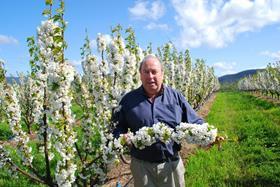
Australian world champion and Olympic gold medallist swimmer Ian Thorpe will be the face of Tasmanian cherries in Japan this December.
The retired swimmer will be representing the white-fleshed Japanese Sato Nishiki cherry variety grown in Tasmania by Reid Fruits as part of a campaign aimed at boosting sales in the market by 50 per cent this season.
The company aims to increase exports of the white-fleshed variety to Japan from last season’s 40 tonnes to 60 tonnes, which will be marketed by Cherry Isle, a collaborative enterprise between Reid Fruits, Top Qual and Hansen Orchards.
“It’s going to be a really exciting promotion,” Reid Fruits’ managing director Tim Reid told Fruitnet.com. “Ian Thorpe has a big image in Japan, a huge profile.”
The major promotion will be run in mid-December and will also involve Japanese-Australian chef Tetsuya Wakuda and Tasmania’s deputy premier Lara Giddings, and has attracted support from Austrade in Japan and the Tasmanian government.
Kicking off with a press conference about Tasmanian production with local media, the campaign will run a seminar and lunch for senior supermarket buyers and distributors.
“Then Ian Thorpe will do some store appearances, and then we’re hoping he’ll be able to do one or two lifestyle TV appearances,” explained Mr Reid. The campaign will be capped off with an event celebrating Tasmanian food at a prestigious restaurant in Tokyo.
This promotion is not Cherry Isle and Reid Fruit’s first in Japan, but it is definitely the largest. With a 50 per cent increase in volumes, a strong Australian dollar and a delicate Japanese economy, Mr Reid said promotions like this are critical to maintaining a good market price.
“There’s a great deal of interest in our product throughout Japan…`but` we need to be investing to make sure we maintain our position through a difficult time,” he stated.
Tasmania gained access to Japan for its cherries in 2005, with the requirement for fumigation then dropped in late 2008, making the market more viable for premium cherries.
Reid Fruit’s production of the Sato Nishiki variety has been ramping up over the last few seasons as the market in Japan shows its potential. The season for the early variety begins in the second week of December, and will be available in the market through into the New Year.
Winter supply of Japanese-variety cherries has huge potential given the volume of summer consumption, explained Mr Reid.
“The Japanese cherries are almost sacred in Japan,” he told Fruitnet.com. “The Japanese produce around 17,000 tonnes of cherries in their own summer, almost all consumed in Japan, and they also import around 10,000 tonnes of cherries from the US at the same time.”
Tasmania’s Japanese-variety cherries have a distinct advantage over Japanese domestic production. Japanese varieties tend to be quite small compared to dark cherries, and from Japanese orchards tend to average around 20mm in size. “But we’ve been doing better than that here – we’re averaging 24-26mm,” stated Mr Reid. “The bigger the better.”
Apart from Japan, the white-fleshed cherries have been seeing some success in other markets in Asia, as well as on the Australian domestic market.
“We’ll be trialling some Japanese-variety cherries into other markets this year,” said Mr Reid. “We’ve got some small repeat orders into Taiwan, and we’ve also got interest in Singapore and Vietnam.”



